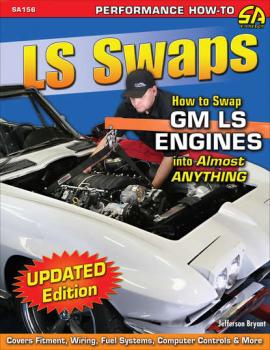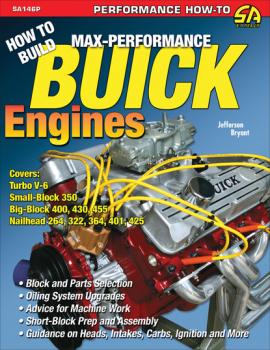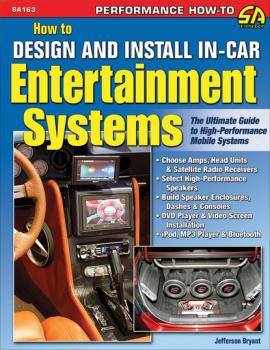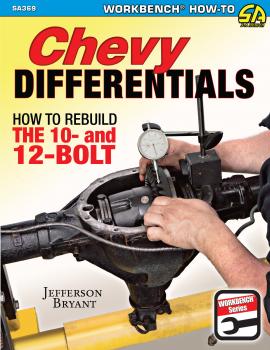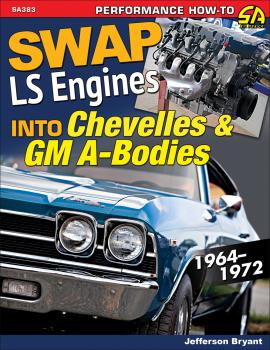Jefferson Bryant
Список книг автора Jefferson BryantLS Swaps
As an all-new edition of the original top-selling title, LS Swaps: How to Swap GM LS Engines into Almost Anything covers the right way to do a spectrum of swaps. So, pick up this guide, select your ride, and get started on your next exciting project.
How to Build Max-Performance Buick Engines
The photos in this edition are black and white.<p>Skylarks, GSXs, Grand Nationals, Rivieras, Gran Sports; the list of formidable performance Buicks is impressive. From the torque monsters of the 1960s to the high-flying Turbo models of the '80s, Buicks have a unique place in performance history. <p>During the 1960s, when word of the mountains of torque supplied by the big-inch Buicks hit the street, nobody wanted to mess with them. Later, big-inch Buicks and the Hemi Chryslers went at it hammer and tongs in stock drag shootouts and in the pages of the popular musclecar magazines of the day. The wars between the Turbo Buicks and Mustang GTs in the 1980s were also legendary, as both cars responded so well to modifications. <p><i>How to Build Max-Performance Buick Engines</i> is the first performance engine book ever published on the Buick family of engines. This book covers everything from the Nailheads of the '50s and early '60s, to the later evolutions of the Buick V-8 through the '60s and '70s, through to the turbo V-6 models of the '70s and '80s. Veteran magazine writer and Buick owner Jefferson Bryant supplies the most up-to-date information on heads, blocks, cams, rotating assemblies, interchangeability, and oiling-system improvements and modifications, along with details on the best performance options available, avenues for aftermarket support, and so much more. Finally, the Buick camp gets the information they have been waiting for, and it's all right here in <i>How to Build Max-Performance Buick Engines</i>.
How to Design and Install In-Car Entertainment Systems
The photos in this edition are black and white.<p>Years ago, enthusiasts had limited in-car entertainment system options. One could install a high-performance head unit, amp, speakers, and upgrade a few other components, and that was about it. Today, in-car entertainment system options are virtually limitless, and they are one of the most popular automotive upgrades. In fact, upgrading or replacing a stock stereo system is just the tip of the in-car entertainment iceberg. <P>Enthusiasts can install a complete entertainment system, including audio and video, MP3 player (iPod), HD radio, satellite radio, and more. Video monitors for DVD and game systems can be incorporated in the dash, head rest, or anywhere else. When you consider GPS navigation and hands-free Bluetooth® cell phone systems, the options are only limited by a person's creativity and budget. <P><I>How to Design and Install In-Car Entertainment Systems</I> presents the entire spectrum of audio/video, navigation, communication, and entertainment technology, and explains how you can create a complete custom system or an integrated stock/aftermarket system. It explains how to plan, select, integrate, and install popular systems under a specific budget for a certain level of performance. This includes design and installation considerations for amps, head units, GPS navigation, iPod integration with head units, satellite radio, digital audio broadcasting, and even computers (carputers). It features how-to installations, thorough explanations for building subwoofer boxes, fabricating kick panels, electrical upgrades such as charging systems, and a comprehensive resource guide.
Chevy Differentials
Millions of Chevrolet vehicles were built and sold in the 1960s and 1970s, and the great majority of those were rear-wheel-drive models with differentials known as 10-bolts or 12-bolts. In Chevy Differentials: How to Rebuild the 10- and 12-Bolt, author Jefferson Bryant walks you through the entire process of procuring, evaluating, and rebuilding the perfect differential for your GM application.
Swap LS Engines into Chevelles & GM A-Bodies
The GM LS engine has revolutionized the muscle car and the high-performance V-8 market. It has become a favorite engine to swap into classic cars because it offers a superior combination of horsepower, torque, and responsiveness in a compact package. As such, these modern pushrod V-8 engines are installed in vintage GM muscle cars with relative ease, and that includes Chevelles and other popular GM A-Body cars. In fact, General Motors manufactured about 500,000 Chevelles and A-Body cars between 1968 and 1970 alone.<p>Jefferson Bryant, author of <i>LS Swaps: How To Swap GM LS Engines into Almost Anything</i>, has performed many LS swaps throughout his career, and has transplanted the LS into several A-Body cars. In this comprehensive guide, he provides detailed step-by-step instructions for installing an LS powerplant into a Chevelle, Buick GS, Oldsmobile Cutlass, and Pontiac GTO. To successfully install an LS engine, you need to select or fabricate motor mounts and adapter plates to mount the engine to the chassis. Also, you need to integrate the electronic engine controls and wiring harness to the A-Body car. If you run a fuel-injection system, a new tank or high-pressure fuel pump, fuel lines, and related equipment must be installed. Bryant covers all of these crucial steps and much more. He explains essential procedures, time saving techniques, and solutions to common problems. In addition, he performs a new LT swap into an A-Body car. <p>Swapping an LS engine into an A-Body is made much easier with a comprehensive guidebook such as this, whether you plan on doing it yourself or decide to have a shop do it for you. A huge and thriving aftermarket provides a wide range of suspension, brake, steering, chassis, and other parts that produce functional improvements. Before you tackle your LS Swap project, arm yourself with this vital information to guide you through the process.
